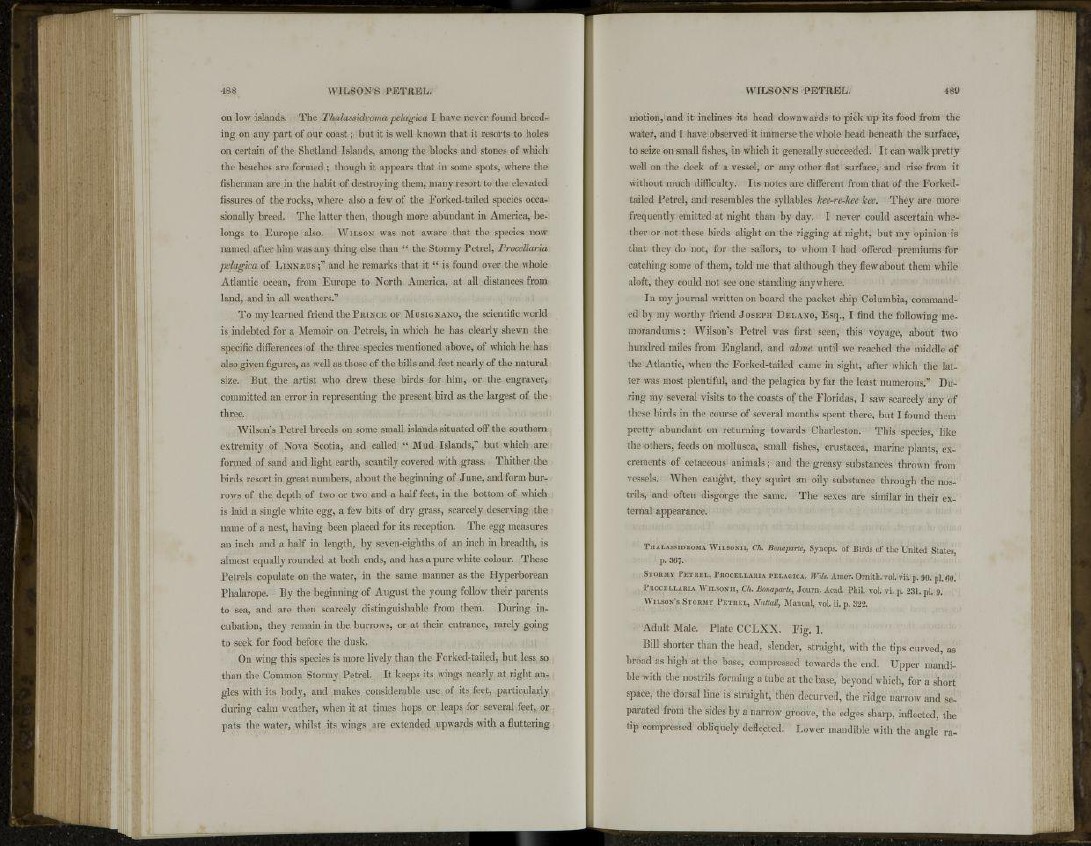
on low islands. The Thalaasklroma pelagica I have never found breeding
on any part of our coast; but it is well known that it resorts to holes
on certain of the Shetland Islands, among the blocks and stones of which
the beaches are formed ; though it appears that in some spots, where the
fisherman are in the habit of destroying them, many resort to the elevated
fissures of the rocks, where also a few of the Forked-tailed species occasionally
breed. The latter then, though more abundant in America, belongs
to Europe also. WILSON was not aware that the species now
named after him was any thing else than " the Stormy Petrel, Procellaria
pelagica of LINNAEUS ;" and he remarks that it " is found over the whole
Atlantic ocean, from Europe to North America, at all distances from
land, and in all weathers."
To my learned friend the PUINCE OF MUSIGNANO, the scientific world
is indebted for a Memoir on Petrels, in which he has clearly shewn the
specific differences of the three species mentioned above, of which he has
also given figures, as well as those of the bills and feet nearly of the natural
size. But the artist who drew these birds for him, or the engraver,
committed an error in representing the present bird as the largest of the
three.
Wilson's Petrel breeds on some small islands situated off the southern
extremity of Nova Scotia, and called " Mud Islands," but which are
formed of sand and light earth, scantily covered with grass. Thither the
birds resort in great numbers, about the beginning of June, and form burrows
of the depth of two or two and a half feet, in the bottom of which
is laid a single white egg, a few bits of dry grass, scarcely deserving the
name of a nest, having been placed for its reception. The egg measures
an inch and a half in length, by seven-eighths of an inch in breadth, is
almost equally rounded at both ends, and has a pure white colour. These
Petrels copulate on the water, in the same manner as the Hyperborean
Phalarope. By the beginning of August the young follow their parents
to sea, and are then scarcely distinguishable from them. During incubation,
they remain in the burrows, or at their entrance, rarely going
to seek for food before the dusk.
On wing this species is more lively than the Forked-tailed, but less so
than the Common Stormy Petrel. It keeps its wings nearly at right angles
with its body, and makes considerable use of its feet, particularly
during calm weather, when it at times hops or leaps for several feet, or
pats the water, whilst its wings are extended upwards with a fluttering
motion, and it inclines its head downwards to pick up its food from the
water, and I have observed it immerse the whole head beneath the surface,
to seize on small fishes, in which it generally succeeded. It can walk pretty
well on the deck of a vessel, or any other flat surface, and rise from it
without much difficulty. Its notes are different from that of the Forkedtailed
Petrel, and resembles the syllables kee-rc-kee kee. They are more
frequently emitted at night than by day. I never could ascertain whether
or not these birds alight on the rigging at night, but my opinion is
that they do not, for the sailors, to whom I had offered premiums for
catching some of them, told me that although they flew about them while
aloft, they could not see one standing anywhere.
In my journal written on board the packet ship Columbia, commanded
by my worthy friend JOSEPH DELANO, Esq., I find the following memorandums
: Wilson's Petrel was first seen, this voyage, about two
hundred miles from England, and alone until we reached the middle of
the Atlantic, when the Forked-tailed came in sight, after which the latter
was most plentiful, and the pelagica by far the least numerous." During
my several visits to the coasts of the Floridas, I saw scarcely any of
these birds in the course of several months spent there, but I found them
pretty abundant on returning towards Charleston. This species, like
the others, feeds on mollusca, small fishes, Crustacea, marine plants, excrements
of cetaceous animals; and the greasy substances thrown from
vessels. When caught, they squirt an oily substance through the nostrils,
and often disgorge the same. The sexes are similar in their external
appearance.
TIIAI.ASSIDB.OAIA WILSONII, Ch. Bonaparte, Synops. of Birds of the United States,
p. 3 6 7 .
STORAIV PETREL, PROCELLARIA PELAGICA, Wils. Amer. Ornith. vol. vii. p. 9 0 . pi. 6 0 .
PROCELLARIA WILSONII, Ch. Bonaparte, Journ. Acad. Phil. vol. vi. p. 2 3 1 . pi. 9 .
WILSON'S STORMY PETREL, Nuttall, Manual, vol. ii. p. 3 2 2 .
Adult Male. Plate CCLXX. Fig. 1.
Bill shorter than the head, slender, straight, with the tips curved, as
broad as high at the base, compressed towards the end. Upper mandible
with the nostrils forming a tube at the base, beyond which, for a short
space, the dorsal line is straight, then decurved, the ridge narrow and separated
from the sides by a narrow groove, the edges sharp, inflected, the
tip compressed obliquely deflected. Lower mandible with the angle ra